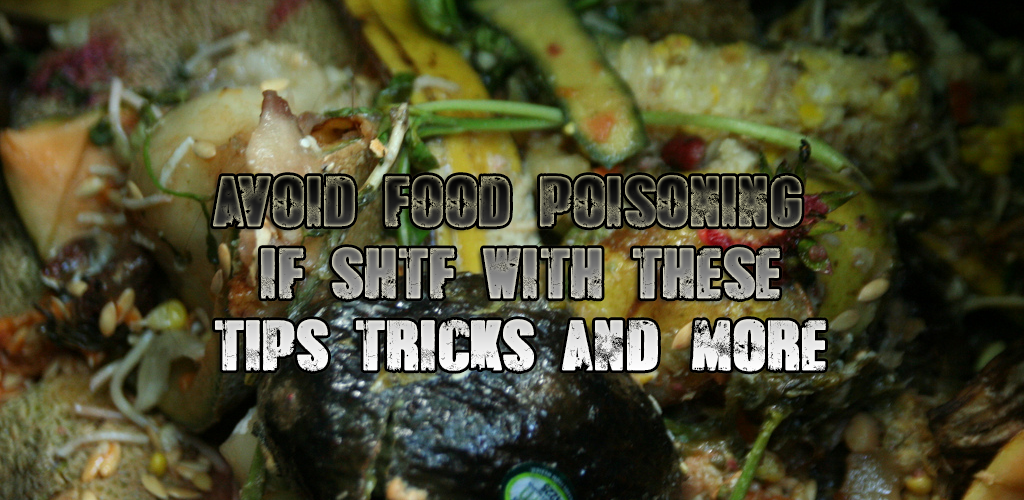There are several reasons why we should be aware of the shelf live of different foods. Mainly to avoid food poisoning & illness. Do not believe that by limiting your food stock to 30 days will keep you safe from spoilage and more. While true that hazards or risks are lowered with a smaller food cache many problems still arise.
- Have you ever had to scavenge for food? If so you need to determine what is and not safe to eat.
- Even with a 30 or 60 day food plan spoilage can play a part in compromising your cache. Meat can thaw or other produce and dairy can warm.
- Food poisoning can be deadly without a crisis at hand. In the middle of a dilemma dangers are greatly enhanced.
- Shelf life and rotation importance. In you want to move forward to a large food cache, planning and establishing a shelf life and rotation schedule are vital in maximizing overall storage capabilities.

As long you understand that your food cache can be compromised in many different ways you understand that a food plan success or failure is impossible to completely predict.
Microbial or non microbial factoring comes into play when food either degrades or becomes dangerous to consume. Some microbial growth can be seen with your own eyes such as mold or loss of consistency.
Other types bacteria are impossible to detect by eye. Consuming food that is contaminated is dangerous and even deadly due to a wide group of different foodborne illnesses.
Throughout this article we will go over the most common types of bacteria and illnesses. Using proper precaution when storing and both food production will greatly hinder microorganisms from compromising your food.
There is also a non bacterial spoilage from moisture loss or gain. Also physical damage such as canned goods being dented or the bruising of fruits and vegetables can heighten food spoilage. Chemical effect can lead to alterations in flavor and color. Light can also expedite vitamin loss, rancidity and physical damage. Insects and rodents can also compromise your food cache.
Foods that normally smell pleasant that develop an unpleasant odor usually due so due to bacterial spoilage. When texture, appearance and flavor are altered from their normal state bacterial spoilage usually can be claimed as the culprit. Look, touch and smell. Don’t taste. Tasting food to see if it is spoiled should be your last resort.
First look for mold, cloudiness, foam or bubbles. If everything looks alright move on to the test of touch. If it has not become slimy put it up to your nose and give it a whiff. If it smells sour, cheesy or putrid it is because it is, throw it out. If it smells, looks and feels good taste a bit to see if its OK. If not and it taste bitter or mushy spit it out immediately and discard the rest of the food.

If any characteristics mentioned are apparent in your food please throw it away at once. Trust your senses. Bacteria can also evade those senses.
For example leaving hotdogs out of the grill sitting in the sun for a prolonged period of time could cause them to spoil early. However the texture and taste of the hotdogs would remain unchanged.
Frozen food stored at 0º F will almost always remain safe from contamination. The only thing compromised from a prolonged freezer stay is the quality of the food. Such as color, flavor, aroma, tenderness etcetera. Some people worry about food that is freezer burned and think it can not be consumed. This is simply not true.
Freezer burn happens when air meets the frozen food item, drying the item out. This usually happens because the item is not wrapped properly. But as mentioned above the food is safe to eat. Just cut away the affected area. You can do this after or before cooking.
If you are looking to gather more information on food safety topics the Department of Health and Human Services has a website at www.foodsafety.gov .It is up to date on food recalls, good safety and food poisoning.
Here is a great tip that many ignore. If you ever fall prey to foodborne illness and believe it is due to food contamination save the package and label the food. Throw it in the freezer (marked as unsafe) and save it for future inspection by health officials. There is also a USDA meat and poultry hotline at 1.888.674.8854 to call if the contamination is from one of those two meats, otherwise call your local health department and inform them.
Avoid Food Poisoning
An estimated 5,000 deaths and 325,000 hospitalizations occur annually in the united states due to foodborne illnesses so claims the CDC. A partnership was established between the USDA and the FDA called “FightBac”. This campaign was created to help combat the far reaches of food poisoning. The message is a clear one that everyone should follow. There are four simple steps to avoiding food poisoning! Clean, separate, cook and chill!
Clean
With hot soapy water, thoroughly wash kitchen utensils, surfaces and your hands. Don’t ever touch food, utensils or kitchen surfaces with dirty hands. Rinsing your fresh vegetables and fruits, gently scrubbing with tap water is also recommended to keep contamination to a minimum. As you know many foodborne illnesses are caused from fecal-oral contamination. Always remember to use a bleach solution (1 gal water to 1 tbsp bleach) to sanitize cutting boards, utensils and counter surfaces.
Separate
Cross contamination can accidentally turn an otherwise perfectly prepared meal into a food-poison riddled trap. To prevent this keep your raw meat, seafood and poultry separated from foods ready to eat. Do not place foods ready to eat on plates or surfaces which previously had raw meat on it .
Cook
The internal temperatures of your meats need to be cooked to specific, safe degrees dependent on the type of food.
Do not always rely on the color of the food to determine if your food is cooked properly or not. Use a clean thermometer to test temperatures.
Chill
Keep takeout and leftovers refrigerated no later than 2 hours after they are served. Keep your cold and frozen foods either cold 34 °F to 40 °F or frozen 0 °F. Perishables should be refrigerated as soon as possible.
It is unwise to defrost food at room temperature, instead that your food in the microwave, refrigerator or even in cold water. Also make sure to cook your thawed food immediately.
Greatly reduce your family’s chance of contracting food poisoning by following these four easy steps. Also for you here are a few more tips to aid you and your family in avoiding food poisoning
- Tap water can often be deemed unsafe. if so cook or peel your fresh produce to not wash it.
- Do not drink water from streams, ponds, lakes or even swimming pools.
- Avoid unpasteurized juice or milk.
- Make sure poultry is cooked thoroughly. If so the meat juice will be clear and not pink.
- Do not eat raw eggs or any food product with raw eggs in it.
Foodborne Illnesses
As mentioned earlier in a time if disaster or emergency an added illness tacked onto already troubled times can wreak absolute havoc or even death. Meeting with a Dr can range from very hard to unlikely given the circumstances surrounding you and medical supplies could be in such high demand and in short supply.
Over the course of the next few pages of his chapter we will go over the main foodborne illnesses in detail. After becoming familiar with these illnesses you will know (unfortunately) how to obtain each illness and the symptoms that they cause.
Salmonella
What it causes: 24 to 72 hours is all it takes for your symptoms to set in. Vomiting, nausea, diarrhea, abdominal pain, fever and headache are your acute symptoms and can last a week. Also arthritic symptoms may be present three to four weeks after the first signs of acute symptoms. It is estimated by the FDA that 2-4 million cases of Salmonella occur each year in the United States.
How to get it: Salmonella is a bacterium usually found in poultry and swine among other animals. It is rod shaped in nature and usually contracted by consuming food contaminated with feces be it human or animal. This is also known as fecal-oral contamination. Wash your hands thoroughly especially after using the toilet as this is often when contamination occurs. Undercooked meat, poultry and eggs, as well as unpasteurized juice and milk are secondary sources of contamination.
Campylobacter Jejuni
What it causes: Two to five days after consumption of the contaminated food or water is the time frame for the start of your symptoms to set in. Fever, abdominal pain, diarrhea, headache, nausea and muscle pain are your symptoms. Seven to ten days is the total duration the illness generally runs but relapses are fairly common. C. Jejuni has been known to spread into the bloodstream becoming, at times fatal. It is estimated by the FDA that 2-4 million cases of C. Jejuni occur each year. C. Jejuni is also the leading cause of bacterial diarrhea in the USA.
How to get it: Once again, most cases are from eating raw or undercooked poultry or cross contamination. Campylobacter Jejuni is a bacterium that causes campylobacteriosis. Usually this bacteria can be found in birds and cattle. Properly cooking chicken will destroy the bacteria but you would do well to know that recent surveys show 20-100% of retail chickens are contaminated with bacteria. Contaminated water and unpasteurized milk are also known to contain the bacterium.
Clostridium Perfringens
What is causes: Eight to Twenty Four hours after consumption symptoms usually start to show. They include diarrhea and abdominal cramps. They are usually over within a twenty four hour period however minor symptoms may be present for two weeks. The elderly may be affected harder as well with symptoms usually lasting a bit longer. C. Perfringens affects an estimated 250,000 people each year in the United States.
How to get it: Decaying vegetation. Also can be found in the intestines of humans & domesticated animals as well as marine sediment. These are the breeding ground for Clostridium Perfringens. Consumption of this bacterium can cause C. Perfringens level food poisoning. Under cooking meat dishes such as stew or preparing them too early in advance are some of the ways of acquiring this bacterium first hand. These outbreaks are more common in large scale kitchens such as hospitals, schools and prisons where food may be left out for too long.
E. Coli
What it causes: Between one and ten days is your timeframe for the initial onset of symptoms. They include diarrhea, severe stomach cramps, bloody stool, fever and or vomiting, respiratory illness and urinary tract infection. The average recovery time is one week. E. Coli can be very dangerous amongst some younger children as they are also susceptible to developing (H.U.S.) Hemolytic-uremic syndrome which is directly related to acute kidney failure. It is estimated by the FDA that there are around 70,000 cases annually in the United States.
How to get it: There are several strains of Escherichia Coli and many are harmless. Usually when you hear of outbreaks in the news they are referring to a more infectious version of the strain such as E. Coli 0157 otherwise known as STEC. Fecal-Oral contamination is how one would contract the bacteria. Coming in direct contact with infected human or animal feces will seal the deal. Also this often happens by consuming contaminated food or water. Unpasteurized milk or undercooked hamburger as well.
Shigella
What it causes: The onset of symptoms such as fever, vomiting, abdominal pain,cramps. difficulty defecating or blood/pus/mucus in the stool usually occur within 12 hours to 4 days. In children under the age of two high fevers and seizures can occur. 300,000 cases of Shigellosis are estimated to occur yearly in the United States.
How you get it: Shigella is a bacteria known to cause Shigellosis. There are many different types of Shigella bacteria, but types B and D are th most common and only known to affect humans, monkeys and chimpanzees. The organism is most commonly found in water polluted by human feces and is often spread through fecal-oral contamination.
It can be contracted by eating contaminated foods usually in the forms of uncooked salads (Tuna, chicken, potato), raw vegetables and milk or dairy products. It is even more commonly contracted via toddlers who are not fully potty trained. Water can be contaminated if another person infected with Shigellosis swims in it, as scary as that may sound.
Clostridium Botulinum
What it causes: This toxin once consumed causes paralysis by blocking motor nerve receptors. In other words… botulism. Starting from the eyes and face a slow paralysis progresses downward moving to the throat, chest, hands and feet. Respiration will become impaired when the chest muscle and diaphragm become paralyzed which can lead to death by asphyxia. There are only between 10 and 30 outbreaks of food related botulism yearly in the United States. However the mortality rate is very high.
How to get it: There are seven types of Botulism (A-G). A,B,E and F cause botulism in humans. While very rare, ingesting food poisoned by this neurotoxin can be fatal. Keep in mind the toxin is heat sensitive and can be eradicated if the host food is heated to 176 °F for at least ten minutes. Sausages, canned vegetables, seafood and meat products are the most likely hosts for human instances of botulism.
Staphylococcus Aureus
What it causes:Symptoms are immediate and consist of vomiting, nausea, abdominal cramping and exhaustion. Changes in pulse and blood pressure are known to occur. Recovery time is usually a few days. This one is hard to pinpoint or diagnose therefore statistics are unavailable.
How to get it: The most widely way known of contracting this type of food poisoning is by eating contaminated foods or through contact with food workers who carry the bacteria.
We hope this helps.
Cover image by stevendepolo
 Survive Our Collapse Building Self-Reliance in an Uncertain World
Survive Our Collapse Building Self-Reliance in an Uncertain World




